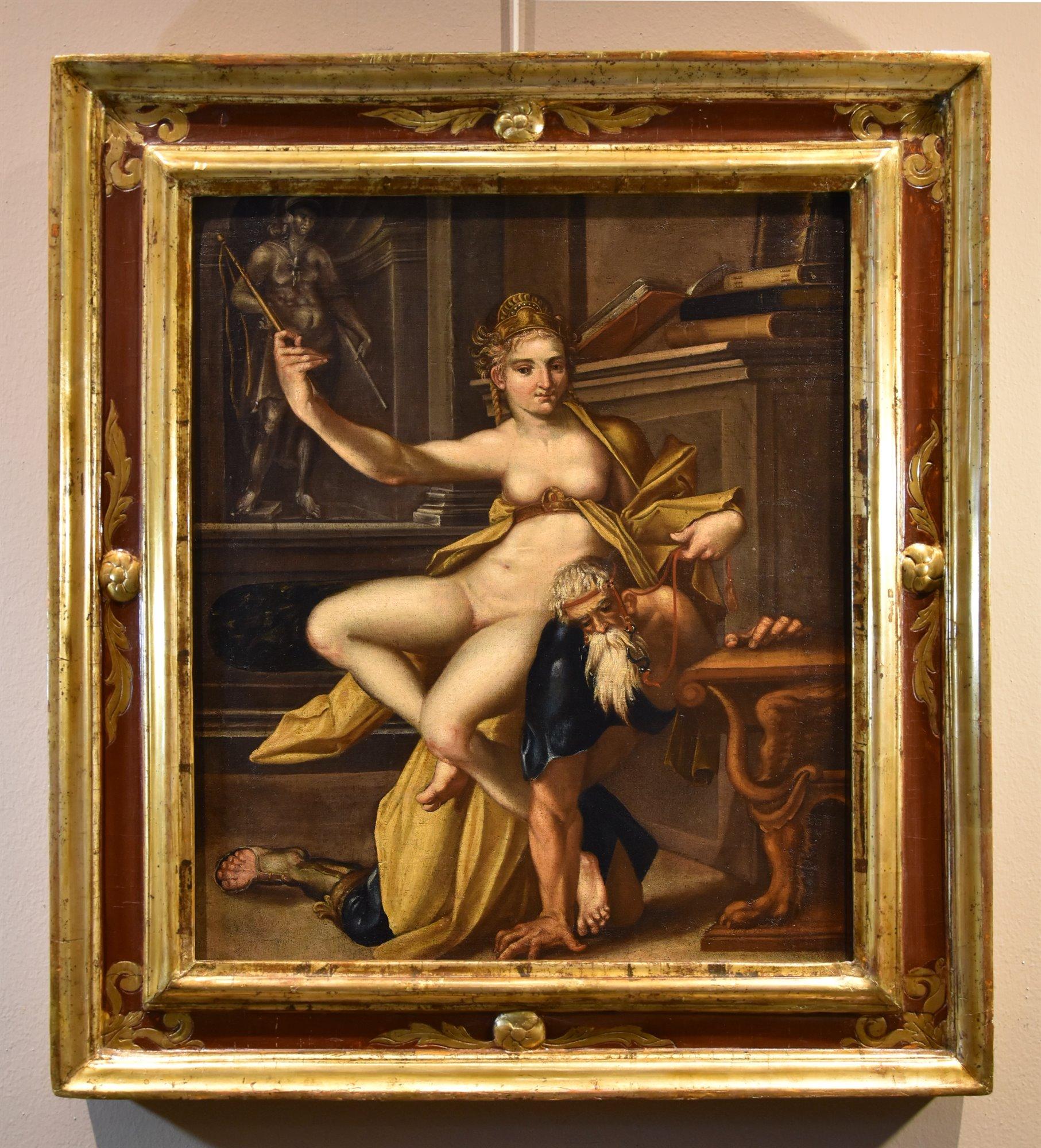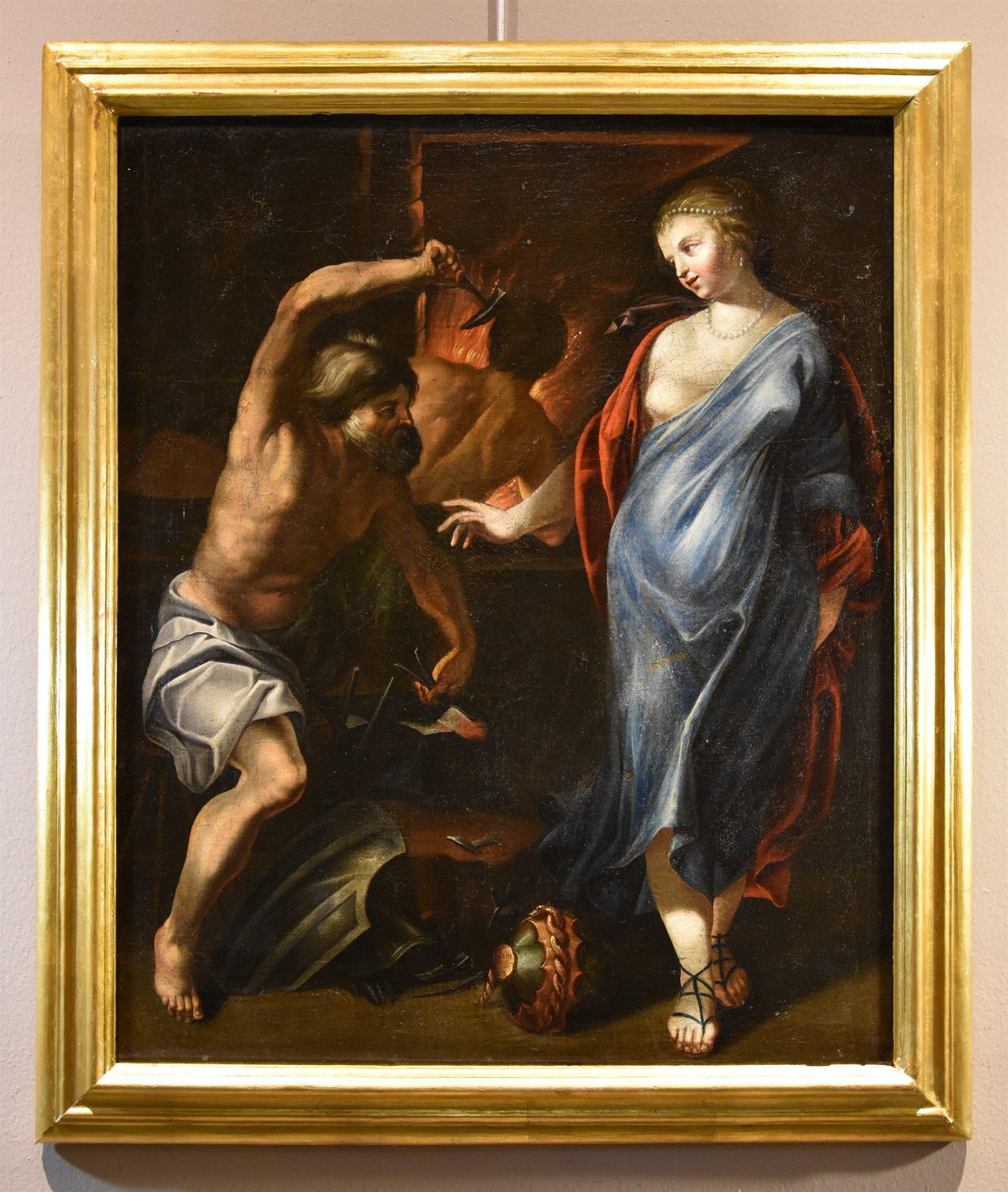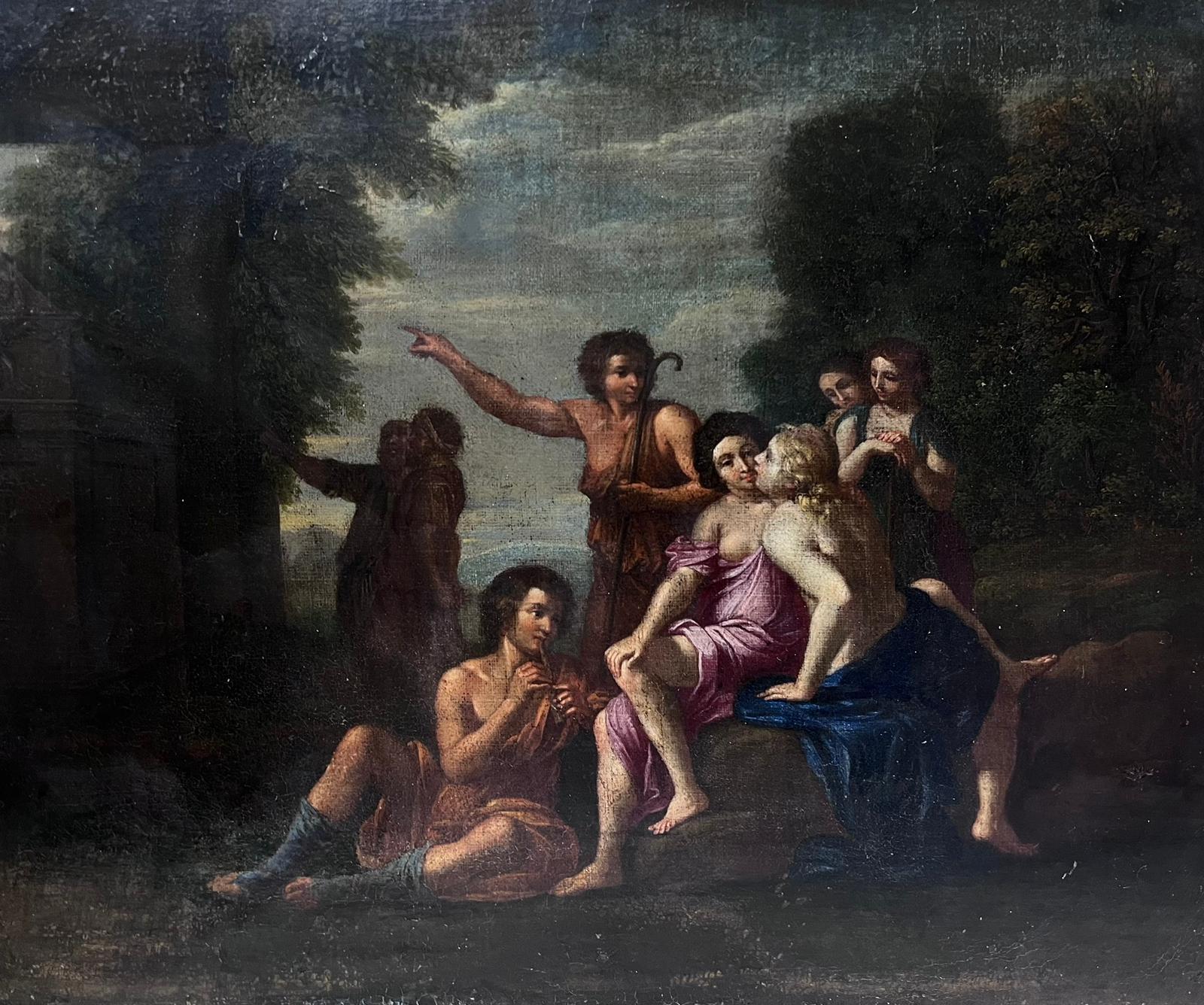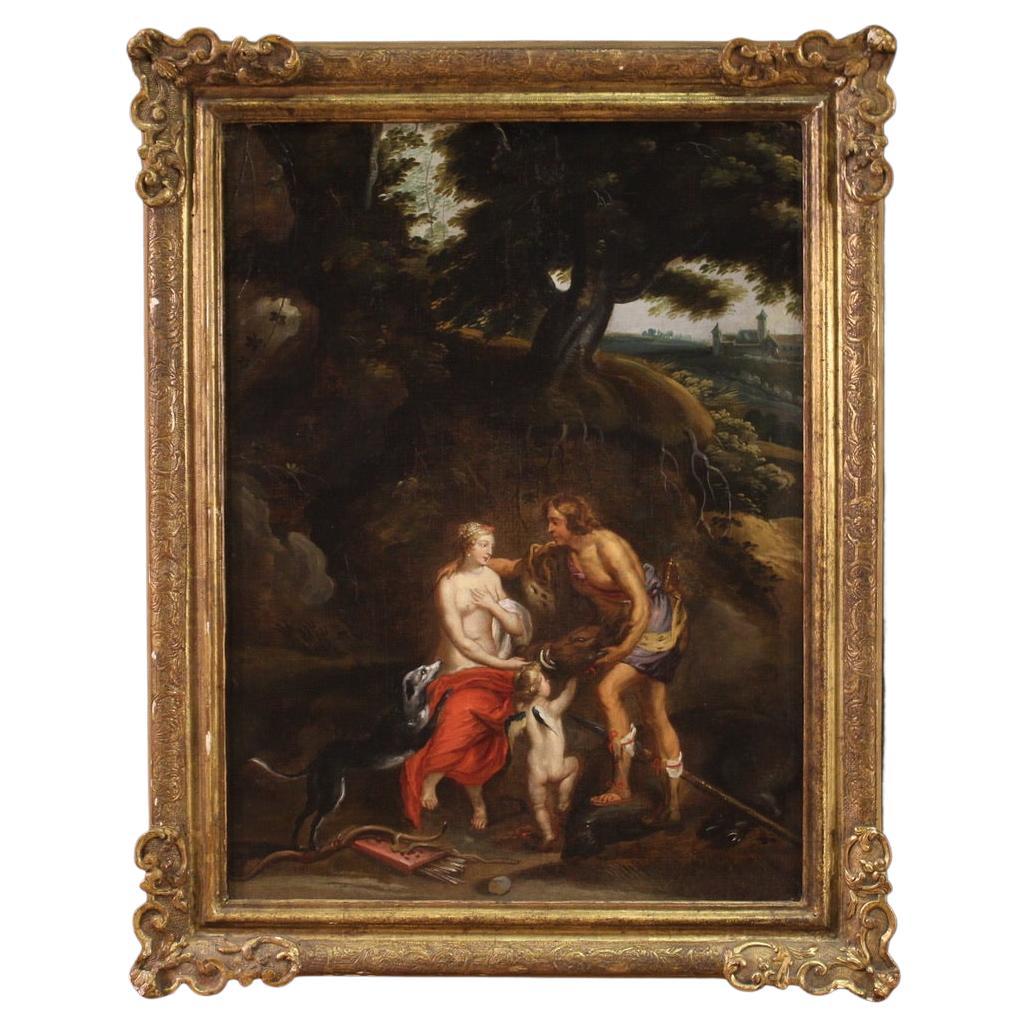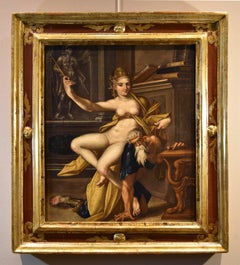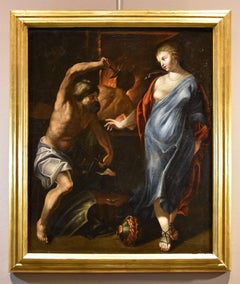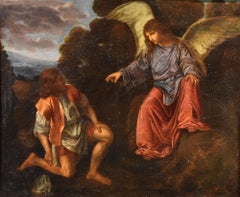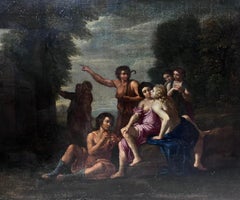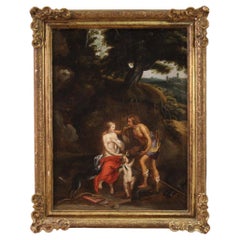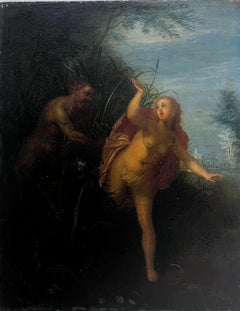Items Similar to Redemption Adam Eve De Backer 16th Century Paint Oil on table Old master Flemish
Video Loading
Want more images or videos?
Request additional images or videos from the seller
1 of 18
Redemption Adam Eve De Backer 16th Century Paint Oil on table Old master Flemish1570-1585
1570-1585
$15,457.61
$19,322.0120% Off
£11,594.40
£14,49320% Off
€13,000
€16,25020% Off
CA$21,578.71
CA$26,973.3920% Off
A$23,372.34
A$29,215.4220% Off
CHF 12,379.02
CHF 15,473.7820% Off
MX$282,770.28
MX$353,462.8520% Off
NOK 155,623.50
NOK 194,529.3820% Off
SEK 145,074.18
SEK 181,342.7320% Off
DKK 99,031.73
DKK 123,789.6720% Off
About the Item
Jacob de Backer (Antwerp, c. 1555 – Antwerp, c. 1585)
The Redemption of Adam and Eve after their Expulsion from Eden
Oil on oak panel (106 x 76 cm - In frame 126 x 96 cm)
The earthly paradise, known as the Garden of Eden, was a place of perfection and happiness where all kinds of delights grew; Adam and Eve were free to eat all the fruits that nature offered them, with the only restriction being that they could not eat from the tree of the knowledge of good and evil.
However, Eve, tempted by the serpent (Genesis 3:1-5), disobeyed God's command, ate the apple from that tree and then persuaded Adam to do the same. The work we are offering shows the consequences of this disobedience, with the expulsion from Paradise and the transmission of original sin to all humanity.
An extremely rare and fascinating theme, Adam and Eve are shown here chained and bound by the angel, symbolising their spiritual death: this iconography plays a key role in Christian theology, reminding us of the consequences of sin and the consequent need for redemption.
Redemption is in fact the key theme of the painting: the great winged angel, majestic, is ready to save the two sinners, granting them the chance of redemption and of regaining God's grace. The painting is attributed to Jacob de Backer (Antwerp 1555–1585), a Flemish painter active in the second half of the 16th century and one of the most important Mannerist masters in Antwerp, occupying a prominent position between the generation of Frans Floris, from whom he was strongly influenced, and that of Rubens.
The painting, clearly the result of a Northern European aesthetic, also demonstrates a significant awareness of Italian art, in particular the influence of late Florentine and Roman Mannerism, as can be seen in the works of Bronzino, Vasari and Salviati. This aesthetic was also very much in tune with the prevailing taste at the Prague court of Holy Roman Emperor Rudolf II, and indeed the inventory of the emperor's estate, drawn up after his death in 1612, lists four works by de Backer.
Many of his compositions, although religious in theme, deal with complex allegorical subjects, which was interpreted as evidence that the artist had received a humanistic education and that his patrons came from the educated class of Antwerp.
This work, in particular, is based on a now lost painting by Marte de Vos, of which an engraving has survived, entitled ‘Allegory of Redemption’ (fig. 1). A painting taken from the original work is now in the Bayerische Staatsgemäldesammlungen (image 2).
Returning to our work, art historian Justus Müller Hofstede suggested in 1973 that the painting was derived from a cycle of five allegorical works painted by De Backer depicting scenes from the life of Jesus (see: Justus Müller Hofstede, Jacques de Backer.
Ein Vertreter der Florentinish-Römischen Maniera in Antwerpen), which appeared in various European sales in recent years. Alongside the composition offered here, we can therefore mention as counterparts the pair of works ‘Nativity’ and ‘Crucifixion’ (image 3 Lempertz Cologne, 14.11.2015, lot 1427), and another ‘Adoration of the Shepherds’ (image 4 Vienna Palais Dorotheum, 25.10.2023, lot 31).
The painting is in good condition with some scratches on the panels.
ADDITIONAL INFORMATION:
The painting is sold complete with a nice frame and comes with a certificate of authenticity and a descriptive iconographic card.
We take care of and organise the transport of the purchased works, both in Italy and abroad, through professional and insured carriers.
If you would like to see this or other works in person, we would be delighted to welcome you to our new gallery in Riva del Garda, at Viale Giuseppe Canella 18. We look forward to seeing you!
Please contact us for any information or to arrange a visit, we will be happy to assist you.
- Attributed to:Jacob De Backer (antwerp, C. 1555 – 1585)
- Creation Year:1570-1585
- Dimensions:Height: 49.61 in (126 cm)Width: 37.8 in (96 cm)
- Medium:
- Movement & Style:
- Period:
- Condition:
- Gallery Location:Riva del Garda, IT
- Reference Number:1stDibs: LU988116518852
About the Seller
4.9
Platinum Seller
Premium sellers with a 4.7+ rating and 24-hour response times
Established in 2017
1stDibs seller since 2018
270 sales on 1stDibs
Typical response time: 3 hours
- ShippingRetrieving quote...Shipping from: Riva del Garda, Italy
- Return Policy
More From This Seller
View AllAnnouncement Waben Signed Dated 1620 17th Century Oil on table Flemish Paint
Located in Riva del Garda, IT
Jacques Waben
(Alkmaar ca. 1575-1641/1642 Hoorn)
Signed in the bottom centre and dated ‘J. Waben f./1620’.
The Announcement to the Shepherds
Oil on oak panel
103 x 63 cm
in frame 107 x 67
Provenance: Vienna Palais Dorotheum Old master painting 10.12.2015 (lot 143)
This is a spectacular depiction of the theme of the annunciation to the shepherds, set in a nocturnal atmosphere dense with photos but refined, the episode of the birth of Jesus reported in the Gospel according to Luke (Lu 2:8-15), in which an angel announces the birth of Christ to a group of shepherds.
We see the scene just as described in the Gospel passage that sets the event at night where the shepherds, intent on watching over their flock, were startled by the sudden appearance of an angel of astonishing beauty who we see here radiating a powerful golden light, while at his side a multitude of other angels from the heavenly army sing praises to God.
After exhorting them not to be afraid, he informed them that a saviour, the Messiah, had been born in Bethlehem, whom they would find wrapped in swaddling clothes in a manger, cared for by the Virgin and St Joseph.
The annunciation to the shepherds was the most depicted night scene in Flemish painting from the 15th century...
Category
17th Century Old Masters Paintings
Materials
Oil
$14,221 Sale Price
20% Off
Aristotle Phyllis Spranger 16/17th Century Paint Oil on canvas Old master
Located in Riva del Garda, IT
Bartholomäus Spranger (Antwerp, 1546 – Prague, 1611) workshop
Aristotle and Phyllis
Oil on canvas 64 x 54 cm In frame 79 x 72 cm
The curious subject of this painting, quite...
Category
16th Century Old Masters Paintings
Materials
Oil
$9,645 Sale Price
20% Off
Thetis Hephaestus Blanchard Mythological Paint Oil on table 17th Century French
Located in Riva del Garda, IT
Jacques Blanchard (Paris, 1600 – Paris, 1638) and workshop
Thetis in Hephaestus' forge (Hephaestus gives Thetis the weapons he forged for Achilles)
Oil on canvas applied to pan...
Category
17th Century Old Masters Paintings
Materials
Oil
$9,274 Sale Price
20% Off
Toby Angel Savoldo Religious 17/18th Century Paint Oil on canvas Old master
Located in Riva del Garda, IT
Giovanni Gerolamo Savoldo (Brescia, c. 1480 – after 1548) Follower of
Toby and the Angel
Oil on canvas 63 x 76 cm - In frame 77 x 90 cm
We are pleased to offer this valuable ...
Category
17th Century Old Masters Paintings
Materials
Oil
$6,801 Sale Price
20% Off
Diana Landscape Muller Signed Paint Oil on table 17th Century Flemish Old master
Located in Riva del Garda, IT
Jacques Muller (Utrecht 1630 - 1680)
Signed: 'J. Muller f(ecit).'
Pupil of Abraham van Cuylenborch (Utrecht, 1620 - 1658)
Diana and the nymphs bathing in a cave
Second half of the ...
Category
17th Century Old Masters Paintings
Materials
Oil
$9,645 Sale Price
20% Off
Terwesten Woman Allegory Art Paint Oil on canvas 17/18th Century Old master
Located in Riva del Garda, IT
Mattheus Terwesten (The Hague, 1670 - 1757)
Portrait of a young woman with palette and brushes, as Allegory of the art of Painting
Oil on canvas
160 x 91 cm. - In frame 178 x 107 cm...
Category
17th Century Old Masters Paintings
Materials
Oil
$11,747 Sale Price
20% Off
You May Also Like
Netherlandish School XVIII Century Monogrammed Old Master Oil Painting
Located in Holywell, GB
Netherlandish School XVIII Century Monogrammed Old Master Oil Painting
An intriguing oil painting of early extraction depicting the crucifixion at Calvary outside Jerusalem. I am s...
Category
18th Century Figurative Paintings
Materials
Oil
17th Century French Old Master Oil Painting Classical Robed Semi Nude Figures
Located in Cirencester, Gloucestershire
17th century French School
circle of Nicolas Poussin (French 1594-1665)
"Figures in Arcadia"
oil on canvas, unframed
canvas: 16 x 20 inches
provenance: private collection, England
condition: very good and sound condition
Nicolas Poussin was a renowned French painter of the 17th century. He is considered one of the greatest figures of classical French Baroque art...
Category
17th Century Old Masters Figurative Paintings
Materials
Oil, Canvas
$5,235 Sale Price
30% Off
17th Century Oil on Canvas Flemish Mythological Antique Painting, 1660
Located in Vicoforte, Piedmont
A splendid 17th century Flemish painting. Oil on canvas artwork depicting a mythological subject of great charm, Meleager offers the boar's head to Atalanta. The Fates had predicted ...
Category
Antique 1660s Dutch Paintings
Materials
Canvas
$8,561 Sale Price
20% Off
17th Dutch Golden Age Old Master Oil on Wood Panel Mythological Nude in Woodland
Located in Cirencester, Gloucestershire
Mythological Figures in Woodland Glade
Dutch School, late 17th century
oil on wood panel, unframed
panel: 11 x 9 inches
provenance: private collection, UK
condition: minor surface sc...
Category
17th Century Old Masters Figurative Paintings
Materials
Oil
Flemish 17th c., Allegory of war and peace, circa 1630, by Adriaen van Stalbemt
Located in PARIS, FR
Adriaen van Stalbemt (Antwerp, 1580-1662)
Allegory of Peace and War, circa 1620-1630
Oil on oak panel: h. 49.5 cm, l. 73.2cm (19.29 x 28.74 in)
Giltwood ...
Category
Early 17th Century Old Masters Figurative Paintings
Materials
Oil, Panel
Fine Quality 17th Century Dutch Old Master Oil on Wood Panel Trial of Christ
Located in Cirencester, Gloucestershire
The Trial of Christ
Dutch Old Master, 17th century
oil on panel, unframed
panel: 11 x 7.5 inches
provenance: private collection, England,
Christies auction stencil marks verso
condi...
Category
17th Century Baroque Portrait Paintings
Materials
Oil, Wood Panel
More Ways To Browse
Flemish Paintings
Antique Paradise
Old Master Flemish
Adam Eve
Antwerp Art
Flemish Masters
Flemish Oil Painting
16th Century Old Master Painting
Antique Flemish Frame
Jacobs Oil Paintings
Old Master Painting Flemish
Figs Paintings
Antique Nativities
Adam And Eve Oil Painting
16th Century Italian Religious Painting
Flemish Table
Adoration Shepherds
Adoration Of The Shepherds
